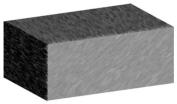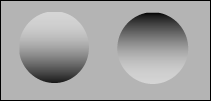Form – From 3D to 2D
The visual world we navigate appears three dimensional. However, the information the visual system uses to generate perceptions is detected by two flat sheets of photoreceptors, one in each eye, offering the brain two 2-dimensional images of the visual world. To achieve the sense of 3-dimensionality we experience, the brain uses a number of cues: perspective, shading/chiaroscuro, stereopsis, occlusion, haze, and relative motion. An artist interested in making a 2-dimensional surface appear three dimensional can use some of the same cues.
Perspective
To get a picture of the world, light from the entire visual field must converge on the retina. It does so by passing through a small hole. As a result, objects further from the eye have a smaller visual angle, making them appear smaller than near objects, which have a larger visual angle and thus appear larger. Artists can use the basic geometry behind this phenomenon to render objects larger when they occur in the foreground and smaller when they occur in the background. The most common form of perspective in drawing is one-point perspective, where one “vanishing point” is chosen and all lines converge at that point. A good example is railroad tracks converging as they fade off into the distance.
Shading and Chiaroscuro
 When a three dimensional object is illuminated the faces of the object reflect different amounts of light depending on their angle to the light source. These differences are detected as changes in luminance, corresponding to the pattern of light falling on the retina. Artists can mimic this with shading, creating a pattern of brightness across an object.
Because we evolved in a world where the fundamental light source was the sun above our heads, the visual system defaults and assumes light is always coming from above. Illuminating one’s face from below achieves a creepy affect, which is why people hold flashlights under their chins when telling ghost stories. When a three dimensional object is illuminated the faces of the object reflect different amounts of light depending on their angle to the light source. These differences are detected as changes in luminance, corresponding to the pattern of light falling on the retina. Artists can mimic this with shading, creating a pattern of brightness across an object.
Because we evolved in a world where the fundamental light source was the sun above our heads, the visual system defaults and assumes light is always coming from above. Illuminating one’s face from below achieves a creepy affect, which is why people hold flashlights under their chins when telling ghost stories.
It also accounts for a cool optical illusion:
 The circle on the left has a luminance gradient characteristic of a three dimensional bulge illuminated from above—as though the upper half were casting a shadow over the lower half—so the visual system perceives it as a three dimensional bulge, while the circle on the right bears a gradient consistent with a depressed region illuminated from above—as though the upper rim were casting a shadow over the upper region—resulting in the perception of indentation. The circle on the left has a luminance gradient characteristic of a three dimensional bulge illuminated from above—as though the upper half were casting a shadow over the lower half—so the visual system perceives it as a three dimensional bulge, while the circle on the right bears a gradient consistent with a depressed region illuminated from above—as though the upper rim were casting a shadow over the upper region—resulting in the perception of indentation.
Notice how gradations in color do not contribute to depth perception:

In order to use shading effectively the artist must be able to see differences in luminance. This is easy enough for achromatic surfaces, but when it comes to painting in color making those discriminations is incredibly difficult. Recall that the Where system, which has high luminance sensitivity, is color blind. Lessons in shading always begin in black and white. Extremely talented artists like Monet, Van Gogh, and Matisse have demonstrated a special finesse for using effective shading in brightly colored works.
Depicted below is a portrait of Matisse by André Derain in color and de-saturated:
In addition to shading the surfaces of objects themselves, artists can generate apparent shifts in the luminance of an object by changing the shading of the background. Recall how center/surround organization allows the visual system to detect local changes in luminance. Shading the background of an image creates changing luminance contrasts at the edge of the object, inducing a gradient within the object (left).
 |
To generate an even wider range of luminance shifting you can shade both the object and the background, but in opposite directions. This is called counter shading (right). |
 |
Stereopsis
When you look upon the world and your eyes converge on the same point, the lateral offset of one eye with respect to the other provides each eye with a slightly different picture. Stereopsis is the ability of your brain to evaluate the discrepancy in these two images to generate a richer sense of depth.
The 3D view-master you may have played with as a child was actually a stereoscope that presented your visual system with laterally offset image pairs of everything ranging from dinosaurs to national treasures.
The Magic eye posters and books you may have encountered work off the same principal, but require more self discipline, since there is no device that can make each of your eyes focus straight ahead.
Here’s an easy stereo view of a molecular channel from a lipid bilayer, try crossing your eyes then slowly let them uncross until you see three images. The center image should be three-dimensional:
About 1 in every 10 people is stereoblind. Their eyes are not perfectly aligned and as a result the pictures sent by each eye to the brain cannot be fused. Cover one eye to get a sense of what stereoblindness is like.
In art, stereoblindness may be an advantage rather than a hindrance. Stereocues are difficult to depict in a 2-dimensional canvas (magic eye is one way of doing this). One common trick used in art schools is to close one eye while drawing, effectively making oneself stereoblind. Without stereo vision, the depth cues are monocular, involving occlusion, perspective, shading and focus. These cues are easier to depict on 2-D surfaces.
In 2004, Margaret Livingstone and Bevil Conway showed that Rembrandt had misaligned eyes, suggesting that he was stereoblind. On top of that, they showed that Picasso, Edward Hopper, Gustav Klimt, Frank Stella, Andrew Wyeth, and numerous other greats had misaligned eyes consistent with stereoblindness. The Conway lab is currently investigating the incidence of stereoblindness in artists and non-artists by testing stereoacuity in both populations. |